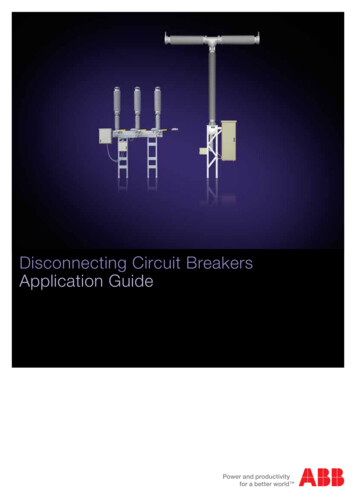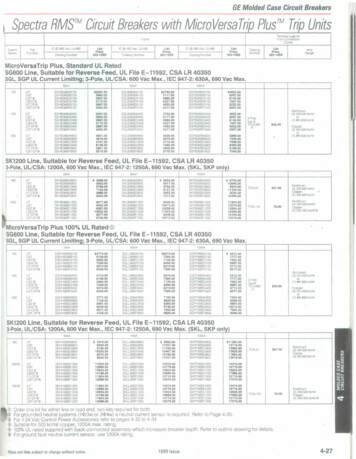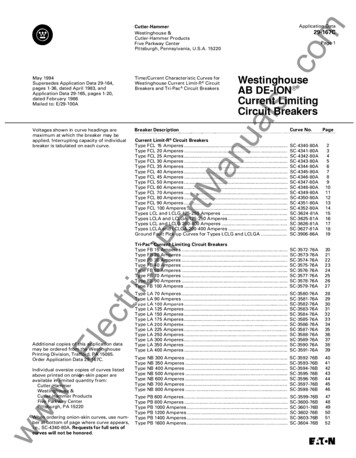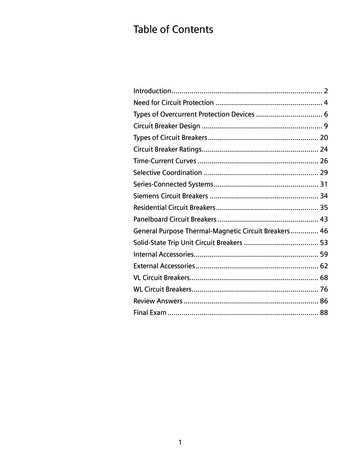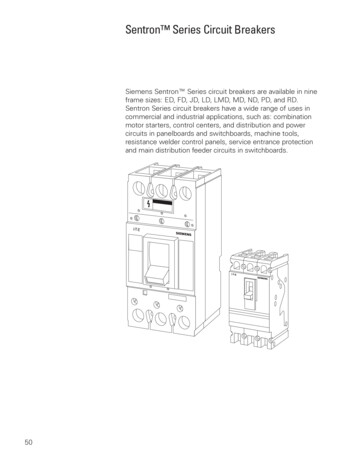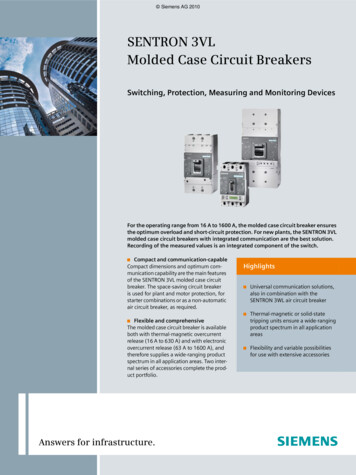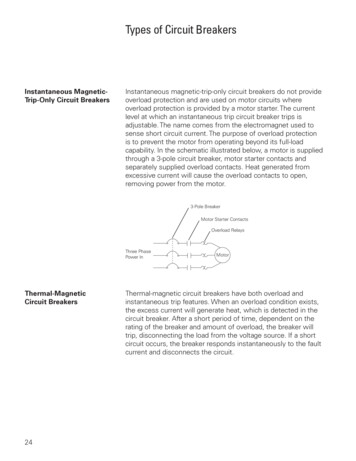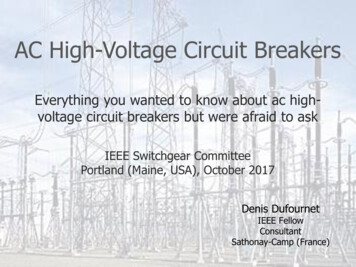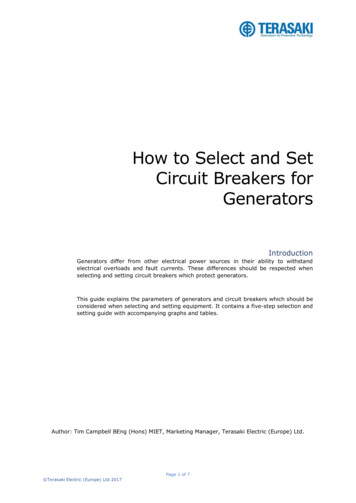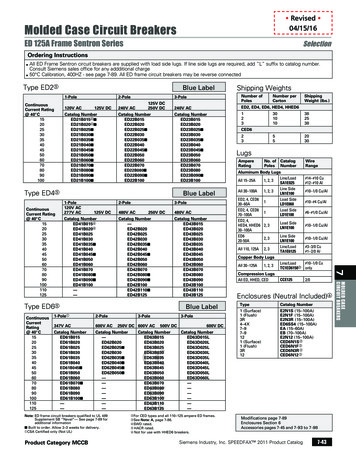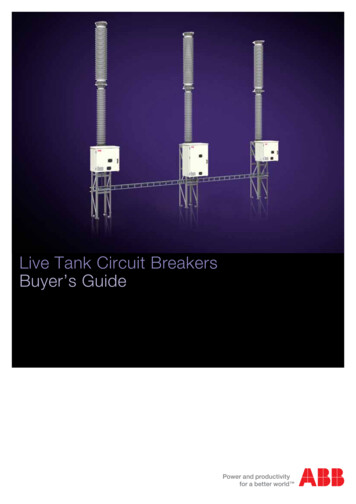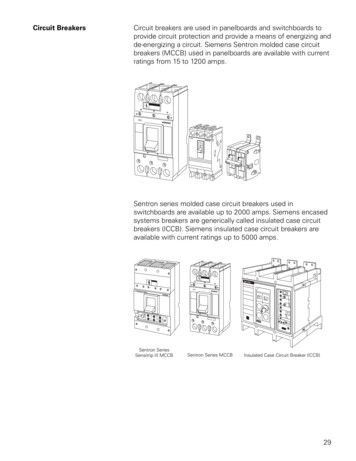
Transcription
Circuit BreakersCircuit breakers are used in panelboards and switchboards toprovide circuit protection and provide a means of energizing andde-energizing a circuit. Siemens Sentron molded case circuitbreakers (MCCB) used in panelboards are available with currentratings from 15 to 1200 amps.Sentron series molded case circuit breakers used inswitchboards are available up to 2000 amps. Siemens encasedsystems breakers are generically called insulated case circuitbreakers (ICCB). Siemens insulated case circuit breakers areavailable with current ratings up to 5000 amps.29
Fusible Disconnect SwitchA fusible disconnect switch is another type of deviceused in panelboards and switchboards to provide overcurrentprotection. Properly sized fuses located in the switch openwhen an overcurrent condition exists. Siemens fusible switchesare available with ampere ratings from 30 to 1200 amps.Bolted Pressure SwitchesBolted pressure switches are also used in switchboards as maindisconnects. Bolted pressure switches are available in ratingsup to 4000 amps.Type RL Circuit BreakerSiemens RL series low voltage power circuit breakers can alsobe used in Siemens switchboards. RL series circuit breakers aredesigned with current carrying capacities up to 5000 amps.30
MetersSiemens offers a full line of power meters for use in the servicesection of switchboards. Meters can be used to measurereal-time RMS (root-mean-square) values of phase currents,phase and line voltages, power usage, power factor, andpeak demand. In addition, Siemens also has meters capableof monitoring power quality, such as K-factor, crest factor,individual harmonics, and total harmonics. Meters such as the9350 and 9600 can act as a Web server. When combined withan Ethernet port, these meters offer quick and easy access tomonitored values without the need for special software.ACCESS Siemens meters have communication capability using theSiemens ACCESS system software. Siemens ACCESS is morethan just power meters and other hardware. The ACCESSpower management and control system is a networked systemcomprised of a variety of devices that monitor and controlan electrical distribution system. The ACCESS system provideselectrical data necessary for troubleshooting, power qualitystudies, preventative maintenance, and cost allocation. Apower monitoring and management system, such as SiemensACCESS, can identify potential problems before they causecostly breakdowns.Here are just five benefits to using the ACCESS system. Reduce or eliminate unplanned outagesProactively manage power systems to minimize utility billsAutomate allocation of utility power billsOptimize existing capital equipment used in power systemsRecord and analyze power quality and power systemanomalies31
TPSComputers and other office equipment are susceptible to thehigh energy levels caused by an electrical surge, whether it iscaused by electrical equipment or lightning. Any componentbetween the source of the surge and ground can be damaged.One option available to protect equipment from electricalsurges is the Siemens TPS (transient protection system). TheTPS clamps voltage spikes before they damage expensive andsensitive equipment. Siemens TPS can be used with busway,panelboards, and switchboards.AC MotorsAC motors, such as the Siemens Medallion motors,can be found in a variety of applications in commercialbuildings. Siemens Medallion EPACT efficiency motors are highperformance motors designed to meet the requirements of theU.S. Energy Policy Act of 1992 (EPAct). EPACT efficiency motorsare available from 1 to 200 HP.Siemens Medallion PE-21 Plus motors are premium efficiencymotors available from 1 to 500 HP. Premium efficiency motorstypically cost slightly more than standard efficiency motors, butpayback is in energy savings.32
Motors can be found on fans, pumps, elevators, escalators,and conveyors. A small conveyor, for example, might be usedin a department store to move packages from a storeroom to acustomer pickup location.Safety SwitchesSafety switches provide a means for a service entrance ora disconnecting means and fault protection for motors. Asafety switch is simply a switch located in its own enclosure.The enclosure provides a degree of protection to personnelagainst incidental contact with live electrical equipment. Safetyswitches are available with or without provisions for fuses.Siemens enclosed switches are available with current ratingsfrom 30 amps to 4000 amps.33
Motor StarterAlthough safety switches can be used to start and stopmotors, many motor applications require the use of remotecontrol devices to start and stop the motor. Motor starters arecommonly used to provide this function. Some motor startershave multi-speed and reversing capability.A motor starter consists of a magnetic contactor and anoverload relay. The contactor is an electromagnetic device usedto close and open a set of contacts, which starts and stopsthe connected motor. If an overload occurs, excessive heat canbuild up in a motor which can damage the motor’s windinginsulation. The overload relay will automatically stop the motorin this event.Siemens manufactures a variety of starters, such as the FurnasINNOVA PLUS and the Furnas ESP100.34
Review 21.may be accessible from the rear as wellas the front?a.c.AboveLoad CentersSwitchboardsb.d.PanelboardsAll the2.is a system manufactured by Siemensto provide protection in panelboards, switchboards, andbusway from electrical surges.3.Switchboards typically consist of a service section andone or more sections.4.The commercial metering switchboardsare designed to meet west coast utility specifications.5.Siemens safety switches are available with currentratings from 30 to amps.35
Industrial ApplicationsVoltage ClassesElectrical power requirement is a major consideration inindustrial applications. Typically voltage is received anddistributed at much higher levels than residential andcommercial applications. Equipment must be specially designedto receive high transmission voltage from a utility company,and effectively distribute it throughout the industrial facility.Industrial facilities typically make large demands on theelectrical utility, making it impractical to supply voltage at lowerlevels. The level of voltage supplied by the utility company varieswith the requirements of the facility. For discussion purposes,it is sometimes convenient to divide voltages into classes.The Institute of Electrical and Electronics Engineers (IEEE), forexample, divides voltage systems into the following classes:Since the voltages supplied to the industrial facilities aretypically either low or medium voltages, this discussion willfocus on low and medium voltage systems beginning with adiscussion of switchgear.36
SwitchgearThe term switchgear is used to describe coordinateddevices used for control and protection of equipment suchas generators, transformers, capacitor banks, motors, anddistribution lines. Switchgear is accessible from the front andrear. Siemens manufactures switchgear for low- and mediumvoltage e switchgear normally conforms to designrequirements for metal-clad switchgear. Siemens manufacturesmedium-voltage switchgear rated at various levels to meet therequirements of typical medium-voltage applications found inmany industrial facilities.38 kV SwitchgearSiemens 38 kV medium-voltage, metal-clad switchgear is ratedfor voltages between 16.5 kV (16,000 volts) and 38 kV (38,000volts). Siemens metal-clad switchgear features 38-3AF circuitbreakers which are available in 1200, 2000, and 3000 ampcurrent ratings.37
5 - 15 kV SwitchgearSiemens 5 - 15 kV metal-clad switchgear is designed to handlevoltages of 4.16 kV (4160 volts), 7.2 kV (7200 volts), and 13.8 kV(13,800 volts). Siemens 5 - 15 kV switchgear features vacuumcircuit breakers rated for 1200, 2000, and 3000 amps.NXAIR PNXAIR P medium voltage switchgear is “arc vented”. Thisdesign handles arc fault events more safely by directingexpanding gases of an arc fault up and away from the operator.NXAIR P meets American standards (ANSI) and internationalstandards (IEC) for global compliance. NXAIR P handlesvoltages from 5 kV to 15 kV with vacuum type circuit breakersrated from 1200 amps to 4000 amps.38
Medium-VoltageSwitchgear ExampleA large industrial facility, such as a paper or steel mill, receiveselectrical power at a substation from the utility company at hightransmission voltage levels. The voltage is stepped down to amedium-voltage level at the substation for distribution by theindustrial facility. Large industrial facilities can be spread outover several acres and incorporate many large buildings. Exactpower distribution will depend on machinery location and powerrequirements. Multiple medium-voltage, metal-clad switchgearunits could be used if the facility and the power demand werelarge enough.It can be seen in this example that one 38 kV metal-cladswitchgear unit is supplying power to two 5 kV metal-cladswitchgear units and one 15 kV metal-clad switchgear unit.This is one way power might be distributed throughout a largeindustrial complex made up of several buildings, each requiringgreat amounts of electrical power.39
Low-Voltage SwitchgearLow-voltage switchgear normally conforms to the designrequirements for metal-enclosed switchgear. Siemens lowvoltage switchgear can be used on distribution systems with208, 240, 480, or 600 volts with currents up to 5000 amps inthe Type R (indoor) and 4000 amps in the Type SR (outdoor). TPS(transient protection system) is available for Type R, low voltageswitchgear applications.Type RL Circuit BreakerSiemens RL series low voltage power circuit breakers areused in the Siemens low voltage switchgear. RL series circuitbreakers are designed for up to 600-volt service with currentcarrying capacities up to 5000 amps.40
Secondary Unit SubstationAnother method used to handle distribution voltage is with asecondary unit substation.A typical secondary unit substation consists of three sectionswhich are coordinated in design to form one uniform enclosure.1.An incoming section that accepts incoming voltage andmay include a primary switch.2.A transformer section that transforms incoming voltagedown to a utilization voltage.3.An outgoing section that distributes power to outgoingfeeders and provides protection for these feeders.A primary switch is used to provide a means to connectand disconnect the secondary unit substation from the supplyservice. The transformer section can be liquid filled, ventilateddry type, or a cast-coil type. The outgoing section can be aSiemens Sentron switchboard, such as the RCIII, or Type R lowvoltage switchgear.41
Small Industrial Facility42A small industrial facility might use a distribution scheme similarto the one shown below. In this example, transmission voltageis stepped down to 15 kV and applied to the input of thefacility’s secondary unit substation. The transformer located inthe substation steps the voltage down to 480 volts where it isdistributed to various switchboards and panelboards.
Large Industrial FacilityA large industrial facility might use a power distribution schemesimilar to the one shown below. In this application power isreceived at the industrial facility’s substation where it is steppeddown to 38 kV for distribution. The distribution voltage is appliedto the input of a 38 kV medium-voltage, metal-clad switchgearunit. One distribution branch is stepped down to 15 kV andapplied to the input of a 15 kV switchgear unit. One of theoutputs of the 15 kV switchgear is applied to the input of asecondary unit substation which uses low-voltage switchgear todistribute 480 volts throughout one section of the facility. Theother outputs of the various switchgear units can be used tosimilarly distribute power.43
BuswayEven in large industrial facilities supply voltage must be reducedto a level that can be used by most electrical equipment.AC motors, drives, and motor control centers, for example,typically operate on 480 volts. General lighting and electricalreceptacles operate on 120 volts. Busway is widely used inindustrial applications to distribute this electrical power.Types of BuswayFeeder busway is used to distribute power to loads thatare concentrated in one physical area. Industrial applicationsfrequently involve long runs from the power source to asingle load. This load may be a large machine, motor controlcenter, panelboard, or switchboard. Feeder busway sections areavailable in 0.125” increments from 2’ to 10’.Plug-in busway is used in applications where powerrequirements are distributed over a large area. Using plug-inunits, load connections can be added or relocated easily.Sentron plug-in busway is available in 4’, 6’, 8’, and 10’ lengths.44
Busway runs also include a number of components such astees, offsets, and elbows used to route busway through thefacility.Busway ExampleIn this example, busway is used to transfer power fromswitchgear located outside a building to a switchboard locatedinside a building. Electrical power is then distributed to variouslocations in the industrial facility. Siemens Sentron busway isavailable with current ratings up to 5000 amps at 600 volts.45
Review 3461.Voltages less than 1000 volts are classed asvoltage.2.Siemens 38 kV medium voltage, metal-clad switchgearis rated between kV and 38 kV.3.Siemens type low voltage switchgear canbe used outdoors.4.The section of a secondary unitsubstation transforms incoming voltage down to autilization voltage.5.busway is used to distribute power to asingle load that is located a long way from the powersource.
de-energizing a circuit. Siemens Sentron molded case circuit breakers (MCCB) used in panelboards are available with current ratings from 15 to 1200 amps. Sentron series molded case circuit breakers used in switchboards are available up to 2000 amps. Siemens encased systems breakers are generically called insulated case circuit breakers (ICCB).
